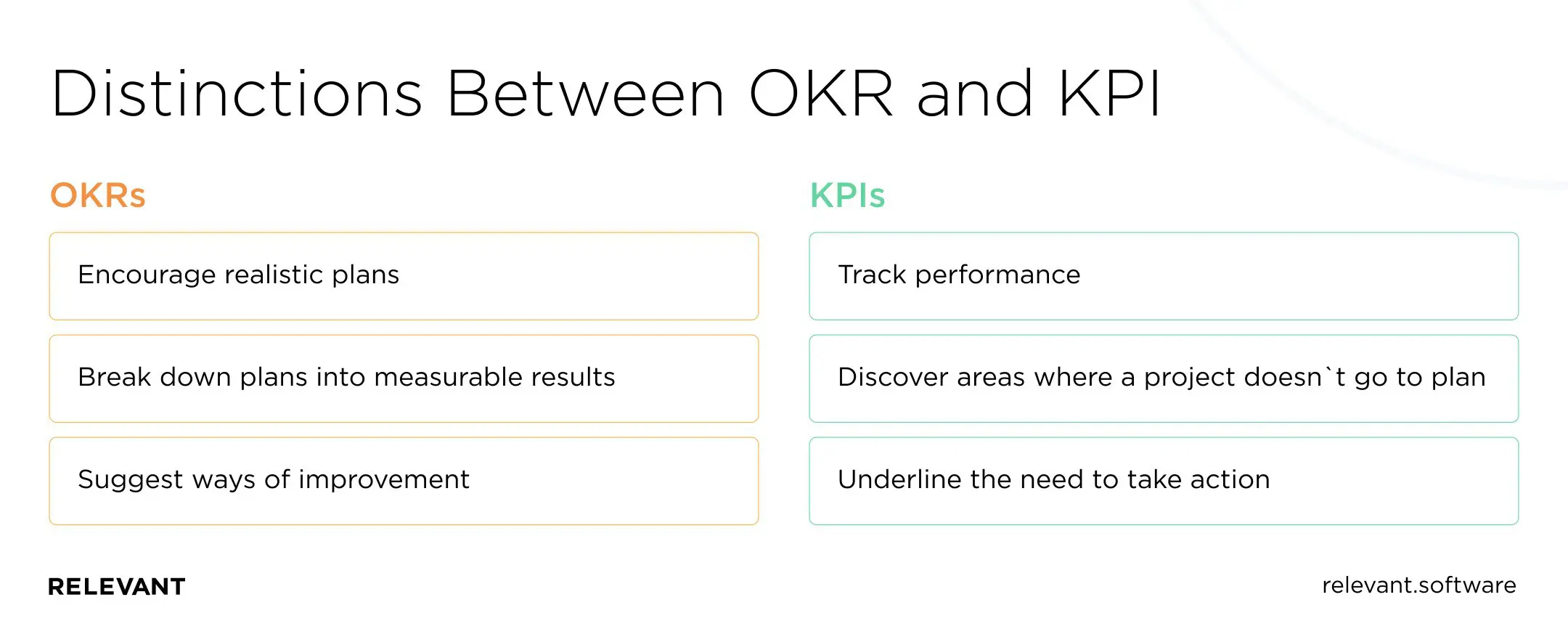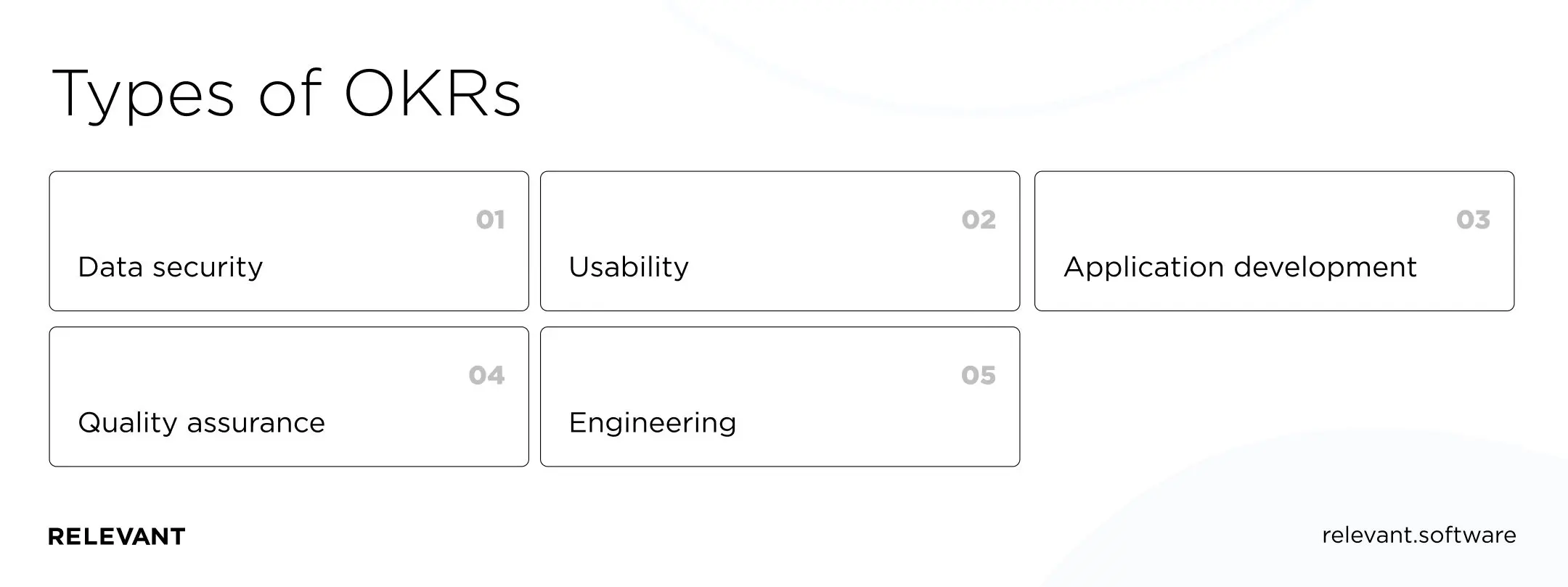The Importance of OKR for a Software Development Team

Do you need OKRs in software development, or is it just a fancy term? Here’s the deal.
Relevant focuses on providing excellent software development solutions to clients across the globe while also assisting them in managing their job responsibilities. Our professional staff of developers and engineers has worked on a wide range of projects, including SaaS, web development, AI & ML, cybersecurity, and more.
We wouldn’t be able to create a successful business and deliver quality results without goal-setting practices. This includes OKRs.
Let’s get into details of what the acronym stands for, what it means, and how to set goals with OKRs.
What is an OKR – Objective and Key Result?
Objectives and Key Results (OKR) are a goal-setting method businesses use to encourage development, innovation, and creativity by setting measurable goals and tracking progress.
Andy Grove, Intel’s co-founder and former CEO, was the first to implement OKRs for attaining the company’s objectives. Setting milestones was important for Intel since a large corporation needed to transform strategic thought into attainable goals and benchmarks.
In his book High Output Management, Grove stressed the necessity of tying key results to goals. Grove believes that OKRs indicate whether or not a company has fulfilled its aims.
OKR in software development, as an endpoint architecture, assisted Larry Page and Sergey Brin in accelerating Google to greater heights, and hundreds of businesses have subsequently learned to harness the OKR process’s principles.
Emerging technologies like FinTech and PropTech have continuously employed goal-setting techniques to discover major advancements in their development processes. Advances in behavioral biometrics in FinTech, for example, are the outcome of a series of procedures that resulted in a sophisticated increase in cybersecurity. These OKR examples for software developers highlight its significance in today’s fast-changing times.
But there’s another frequently-used and probably more familiar acronym in software development – KPI, or Key Performance Indicator. Both set goals and track progress. So are they interchangeable?
OKRs are not KPIs
OKR and KPI do sound like interchangeable ideas; however, this is not the case. In reality, they both provide unique perspectives on your software development process.
When their standards are combined, they produce a holistic picture of the firm. As a result, rather than selecting between KPIs and OKRs, find a way to use both.
But first, it’s important to understand the distinctions between OKR and KPI.
Assume one of your KPIs reveals that the popularity of and engagement with your software have decreased. The KPI does not explain why this is the case or how to improve it. It just underlines the need to take action in this sector. Consequently, you may develop an OKR that delves into the issue and suggests ways to improve customer engagement and retention.
As a result, OKRs and KPIs are complementary rather than diametrically antagonistic:
- OKRs encourage you to create realistic plans and break them down into measurable results.
- KPIs enable you to track performance and discover areas where things aren’t going as intended.
KPIs are thus a critical part of OKRs. Therefore, OKR in software development will guide the KPIs you use to monitor the progress of the project.
So, ideally, you need both. But what will OKRs give you?

Why should a startup implement OKRs?
If you operate a startup, developing and setting an OKR in software development will improve your company’s productivity. The following reasons make OKRs a must for every startup:
Focus
An OKR enables you to concentrate on a limited set of objectives and accomplish remarkable achievements in those domains.
Since you can only concentrate on very few aspects as an individual or corporation, it is recommended to set no more than five strategic goals and five essential outcomes for each goal.
Alignment
Strategically aligned OKRs get everyone on the same page quickly, pushing for greater efficiency, productivity gains, and fewer company expenditures. This is achieved by synchronizing your objectives at the individual, team, and organizational levels.
Commitment
Consider taking a vacation without knowing where to go, what to avoid, what to eat, and so on. Do you believe you can have a nice trip without committing? The same holds true for employing OKRs to achieve corporate objectives.
A quality-focused goal can be paired with an efficiency-focused goal. Keep in mind that you are choosing what you should and shouldn’t commit to at the same time.
Tracking
After establishing your OKRs, make sure your statistics are documented in a monitoring system. You can configure milestones on a unified platform and then compare progress against those milestones to decide if your project is in danger, behind schedule, or on track.
It is also essential to ensure that everybody stays on track each week while evaluating OKRs. Remember to assemble as a group to evaluate and discuss the data after your OKRs are declared complete.
Stretching
Companies frequently set stretch goals. Such targets are just beyond the horizon of what appears to be achievable. Such objectives help you attract the smartest people and foster the most interesting work cultures. Furthermore, when set high, stretch targets provide successful contributions.
There’s value in such goal setting, but maybe it will be more clear with some software developer OKR examples.
Examples of software engineering OKRs
In this section, let’s take a closer look at what kind of OKRs there are and how they can benefit your business.
Data security OKRs
Data safety OKRs can be used to break the support team’s development and testing deadlock by diverting focus to specific security upgrades. This can be done by, for example:
- Monitoring phishing attempts
- Reducing reaction time
- Employing automated analysis
- Screening for security threats
- Getting comprehensive visibility into network traffic
Remember that these goals are specific to your company. But whichever milestones you choose, their success rates should be around 70%; anything closer to 100% success implies that the goal is probably not ambitious enough.
Usability OKRs
Evaluating the current status of your website’s or app’s user experience necessitates the usage of specialized tools and usability OKRs. A UX OKR may improve the consumer experience by providing significant insights into their preferences. Usability OKR examples for software developers include, for example:
- Testing and monitoring new web pages or designs to assure bug-free operation
- Improving loading speed and performance
- Increasing product usability scores
Application development OKRs
You can produce flexible products and avoid recurring disasters by simplifying the software development life cycle. Setting OKRs allows you to track your progress toward increasing development quality. For example:
- Improve code unit test coverage from 40% to 60%
- Test application development using X, Y, Z tools on five unique features
Quality Assurance OKRs
Assume you’ve finally published the beta version of your program and want feedback on how to enhance it. What are your plans in this situation? Create quality assurance OKRs and track the results of each variable.
[e-book id=”8445″]
A few OKR examples for software development are:
- Collecting customer feedback to evaluate your product experience
- Obtaining written reviews from important websites and newspapers
- Publishing your product journey on GitHub
Engineering OKRs
Leveraging engineering OKRs to create your app or software is a fantastic way to concentrate and align priorities with the rest of your business. The software development business moves at a breakneck rate. Setting OKRs for the engineering team may combine the limitless features of the innovation with the associated restrictions to guarantee that the team’s creativity can consistently provide real outcomes. For example:
- Increasing product stability
- Reducing unplanned downtime
- Increasing hardware and infrastructure dependability
Setting these or other OKRs is just part of the deal. Another part is making sure your people fulfill them.

OKRs depend on the team
Team OKRs describe the methods your team will employ and the results they must obtain to help your company achieve its long-term goals. Everyone has a busy schedule, and important things will always come up, but whatever is stated in your OKRs should take precedence above anything else.
OKRs instill a sense of duty and purpose in your workforce. They are, however, driven to say “no” to anything that does not fall within the scope of the OKRs. Assume that each team creates their OKRs as though these are the only activities they should be concentrating on during that period. In such a scenario, it will ensure a fruitful OKR strategy while also assisting your company in attaining its goals.
Hire a highly motivated dev team in Ukraine
Presume you’re in the middle of a pitch to an investor. You’ve been working on your conceptual design for a few months now, but you’ve realized you need to pivot. You are confident that you must create this disruptive new service or functionality to demonstrate that your idea is valuable.
You now have one month to come up with something completely fresh and present it to potential investors at Demo Day. Don’t worry; you can delegate your project to a company in Ukraine, as it is one of the best countries to outsource software development.
Examine Relevant Software’s services and portfolio before making a selection. We have a dedicated software development team eager to begin working on new projects.
Conclusion
OKR success stories from Google, LinkedIn, and Intel have inspired many more businesses to adopt the framework. However, some businesses fail to implement OKRs. A lack of understanding among teams regarding the role team OKRs play is a key cause of failure. Team OKRs should reflect and complement your corporate vision for the OKR to be effective.
However, keep in mind that each member requires their own OKRs to produce what is necessary. Consequently, outsourcing to Ukraine might be a great way to save time and focus on your company’s core duties. Contact the Relevant team for your next project!



